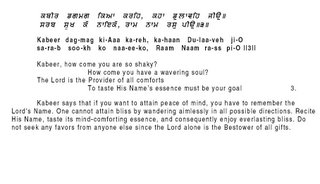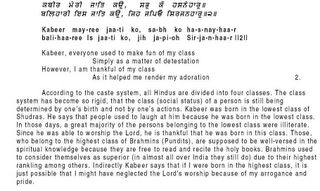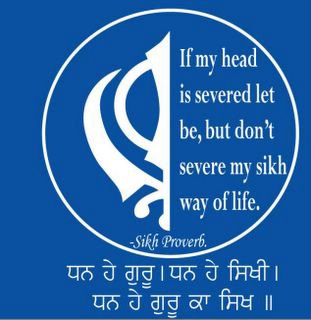Sunday, April 30, 2006
Saturday, April 29, 2006
Friday, April 28, 2006
Shaloks of Bhagat Kabeer jee....

Everyone knows the importance given to Bhagat Kabeer jee's Bani in Sri Guru Granth Sahib jee Maharaaj. I'm trying to present one shalok at a time that I found on the web. It is a PDF file so I'm not sure what the quality will be as far as the reading is concerned. When you click on the image, it will open into a readable window...
Women and Sikhism....
Sir Guru Nanak Dev Sahib jee Maharaaj exalted the status of woman by saying : "It is from women, the condemned one, that we are conceived and it is from her that we are born. It is to the women that we are engaged and married. It is the woman who is our life - long friend and it s she who keeps our race going. It is women again who is sought when one loses one's previous wife. It is woman through whom we establish our social ties. Then why denounce her form whom even kings and great men are born."
Wednesday, April 26, 2006
Baba Budha jee... The first appointed Granthi ....
Baba Budha Ji is recognized as one of the great Sikhs of the Guru period. He had the privilege of being blessed by the first six Gurus. He led an ideal Sikh life for more than a hundred years.
Baba Ji was born to Bhai Sugha in 1506 in village Kathu Nagal, district Amritsar. His parents named him Burha. He was only a child, when the family migrated to village Rumdas. Burha, being the son of a farmer, used to graze cattle like other boys of his age in the village. When Guru Nanak Dev Ji visited their village, he listened to the Guru preach.
Impressed by the sermons, one day he brought fresh milk for the Guru to have a chance to talk to the Guru directly. The Guru was pleased with his devotion. Bhai Burha Ji asked the Guru about the mission of human life and the way to achieve it. Guru Ji responded, "You are a young boy, but you are talking like a Budha, an experienced senior citizen." Since then, Bhai Burha became popular with his new name, Baba Budha Ji.
As advised by the Guru, Baba Ji adopted the life of a Sikh. He recited Gurbani, shared his earnings with the needy and wished well for everyone. People were much impressed by his lifestyle and devotion to service. Guru Ji also appreciated his living as an ideal Sikh.
Guru Nanak Dev Ji after his preaching tours to different countries in Asia, settled at village Kartarpur. Baba Ji would visit him to listen to the holy kirtan and the teachings of the Guru. One day, he was summoned by the Guru to Kartarpur for a special assignment. When Baba Budha Ji reached there, Guru Nanak told him to put a mark of respect on the forehead of Bhai Lehna Ji who was nominated as the successor to Guru Nanak.
Baba Budha Ji lived a long life of more than a hundred years. He was always called upon to perform this sacred assignment whenever the Guruship was passed on to the next successor. Baba Ji lived long enough to serve Guru Har Gobind, the sixth Nanak. Because of this honorable status, he was loved and respected very much by the Sikh masses.
When the work of digging the Amrit Sarovar was undertaken during the time of Guru Ram Das and continued through the Guruship of Guru Arjan Dev Ji, Baba Ji was nominated as the coordinator of the volunteers. There still stands a jujubee tree on the border of the Sarovar where Baba Ji sat while performing his responsibilities. After the completion of the construction work at Amritsar and the installation of the Sikh holy scripture, Baba Ji was honored as the first Granthi of the Harimandar Sahib.
After his sewa at Amritsar was over, Baba Budha Ji was given another important assignment at village Jhabal. A Sikh had offered Guru Ji a large piece of land in that village. The property was covered by trees and grazing lands. Milch animals and the horses of the Guru were kept there. Since Baba Ji was in charge and took care of the animals, the place became popular as Bir Baba Budha Ji. In memory of his services, a gurdwara now stands there with the same name.
Guru Arjan Dev Ji sent his son, Har Gobind, to that place and put him under the charge of Baba Ji. He was to teach the young boy to read and understand Gurbani, horse riding, wrestling, use of arms and other arts of defense.
Knowing that his body had become very weak and that death was not very far away, Baba Ji requested the Guru to let him move to his own village of Rumdas. When he was about to die, Guru Har Gobind was there to bless him. Baba Ji died in 1631, at the mature age of 125 years. Baba Ji earned a permanent place in the minds of the Sikh community for his services to the Guru.
(The material assimilated from varoius web sites and books.)
Baba Ji was born to Bhai Sugha in 1506 in village Kathu Nagal, district Amritsar. His parents named him Burha. He was only a child, when the family migrated to village Rumdas. Burha, being the son of a farmer, used to graze cattle like other boys of his age in the village. When Guru Nanak Dev Ji visited their village, he listened to the Guru preach.
Impressed by the sermons, one day he brought fresh milk for the Guru to have a chance to talk to the Guru directly. The Guru was pleased with his devotion. Bhai Burha Ji asked the Guru about the mission of human life and the way to achieve it. Guru Ji responded, "You are a young boy, but you are talking like a Budha, an experienced senior citizen." Since then, Bhai Burha became popular with his new name, Baba Budha Ji.
As advised by the Guru, Baba Ji adopted the life of a Sikh. He recited Gurbani, shared his earnings with the needy and wished well for everyone. People were much impressed by his lifestyle and devotion to service. Guru Ji also appreciated his living as an ideal Sikh.
Guru Nanak Dev Ji after his preaching tours to different countries in Asia, settled at village Kartarpur. Baba Ji would visit him to listen to the holy kirtan and the teachings of the Guru. One day, he was summoned by the Guru to Kartarpur for a special assignment. When Baba Budha Ji reached there, Guru Nanak told him to put a mark of respect on the forehead of Bhai Lehna Ji who was nominated as the successor to Guru Nanak.
Baba Budha Ji lived a long life of more than a hundred years. He was always called upon to perform this sacred assignment whenever the Guruship was passed on to the next successor. Baba Ji lived long enough to serve Guru Har Gobind, the sixth Nanak. Because of this honorable status, he was loved and respected very much by the Sikh masses.
When the work of digging the Amrit Sarovar was undertaken during the time of Guru Ram Das and continued through the Guruship of Guru Arjan Dev Ji, Baba Ji was nominated as the coordinator of the volunteers. There still stands a jujubee tree on the border of the Sarovar where Baba Ji sat while performing his responsibilities. After the completion of the construction work at Amritsar and the installation of the Sikh holy scripture, Baba Ji was honored as the first Granthi of the Harimandar Sahib.
After his sewa at Amritsar was over, Baba Budha Ji was given another important assignment at village Jhabal. A Sikh had offered Guru Ji a large piece of land in that village. The property was covered by trees and grazing lands. Milch animals and the horses of the Guru were kept there. Since Baba Ji was in charge and took care of the animals, the place became popular as Bir Baba Budha Ji. In memory of his services, a gurdwara now stands there with the same name.
Guru Arjan Dev Ji sent his son, Har Gobind, to that place and put him under the charge of Baba Ji. He was to teach the young boy to read and understand Gurbani, horse riding, wrestling, use of arms and other arts of defense.
Knowing that his body had become very weak and that death was not very far away, Baba Ji requested the Guru to let him move to his own village of Rumdas. When he was about to die, Guru Har Gobind was there to bless him. Baba Ji died in 1631, at the mature age of 125 years. Baba Ji earned a permanent place in the minds of the Sikh community for his services to the Guru.
(The material assimilated from varoius web sites and books.)
Friday, April 21, 2006
"Rehet Aavar Kuch Aavar Kamavat, Man Nahi Preet Mukho Gand Lavat" - Sukhmai Sahib...
This is a Sakhi about Sajjan Thug who's deeds were opposite to what his name meant.
Sajjan means a nice person, a friend, a helper. There was a man with this name living in Tulamba (now in Pakistan). He was known as a good man in his area. He had constructed an inn for travelers to rest for the night.
Whenever a traveler would forget anything in the inn, Sajjan kept it as his own. Slowly he developed the bad habit of stealing valuables of the travelers when they were sleeping at night. After some time, this bad habit made him a wicked man. He even killed people staying at his inn if he wanted to take away the travelers' belongings. A "sajjan" because of his bad habits thus became a "thug." The people, therefore, called him "Sajjan Thug."
On one of their journeys Guru Nanak Dev and Bhai Mardana stayed with Sajjan Thug for the night. In the evening Guru Nanak Dev sang a shabad while Bhai Mardana played on the rebab. The shabad explained that if a person is bad at heart, an outward show of good acts means nothing. God knows our mind and no one can bluff Him. The true friends (sajjan) are actually the good deeds of a man. These good deeds help the man not only here in this world but also after death in the next life. By evil acts man makes his mind dirty, because of which he not only suffers here in this world, but also his soul remains dirty even after death.
Sajjan Thug had been listening to this shabad attentively. As the shabad went into his ears, his mind started "seeing" the truth. He realized he was an evil man. He was taking away the belongings of innocent travelers to whom he was supposed to provide comfort and service.
Sajjan Thug went to the Guru, folded his hands and confessed before the Guru that he was Sajjan only by name. Actually, by his deeds he was a Thug. Sajjan Thug sincerely repented and promised to lead a holy life in the future.
The Guru was pleased by the change of his heart and he was, therefore, very kind to Sajjan Thug. Sajjan was advised to distribute all the ill-got money to the needy and start his life afresh as an honest man. He sincerely practiced as the Guru advised him. He started helping the visitors and making their stay comfortable by whatever he could do for them.
Thus, a Sajjan by name, became a Sajjan by his deeds as well, after meeting Guru Nanak.
(The material assimilated from varoius web sites and books.)
Sajjan means a nice person, a friend, a helper. There was a man with this name living in Tulamba (now in Pakistan). He was known as a good man in his area. He had constructed an inn for travelers to rest for the night.
Whenever a traveler would forget anything in the inn, Sajjan kept it as his own. Slowly he developed the bad habit of stealing valuables of the travelers when they were sleeping at night. After some time, this bad habit made him a wicked man. He even killed people staying at his inn if he wanted to take away the travelers' belongings. A "sajjan" because of his bad habits thus became a "thug." The people, therefore, called him "Sajjan Thug."
On one of their journeys Guru Nanak Dev and Bhai Mardana stayed with Sajjan Thug for the night. In the evening Guru Nanak Dev sang a shabad while Bhai Mardana played on the rebab. The shabad explained that if a person is bad at heart, an outward show of good acts means nothing. God knows our mind and no one can bluff Him. The true friends (sajjan) are actually the good deeds of a man. These good deeds help the man not only here in this world but also after death in the next life. By evil acts man makes his mind dirty, because of which he not only suffers here in this world, but also his soul remains dirty even after death.
Sajjan Thug had been listening to this shabad attentively. As the shabad went into his ears, his mind started "seeing" the truth. He realized he was an evil man. He was taking away the belongings of innocent travelers to whom he was supposed to provide comfort and service.
Sajjan Thug went to the Guru, folded his hands and confessed before the Guru that he was Sajjan only by name. Actually, by his deeds he was a Thug. Sajjan Thug sincerely repented and promised to lead a holy life in the future.
The Guru was pleased by the change of his heart and he was, therefore, very kind to Sajjan Thug. Sajjan was advised to distribute all the ill-got money to the needy and start his life afresh as an honest man. He sincerely practiced as the Guru advised him. He started helping the visitors and making their stay comfortable by whatever he could do for them.
Thus, a Sajjan by name, became a Sajjan by his deeds as well, after meeting Guru Nanak.
(The material assimilated from varoius web sites and books.)
Tuesday, April 18, 2006
Hurricanes
My cousin who lives in South Florida sent me some pictures from last years Huricane season. I'm publishing them as this years Hurricane season is just less tha a month and a half to begin and it is said that this year it will be even more active than last. Whole of south Florida was in dark and my cousin got the power back the 14th day....
Sunday, April 16, 2006
Dare Devil performance of the Khalsa....

The 307th anniversary of establishing Khalsa just went by so I am posting a Sakhi of Dare Devil performed by Khalsa in the 18th century.
Two brave saint soldiers are famous for their daring deed of cutting the head of an evil man, Massa Rangar who was desecrating the Golden Temple in 1740. These two Lions were Bhai Sukha Singh who belonged to the village Mari Kamboki and Bhai Mehtab Singh who belonged to the village Meeran Kote, both in the district of Amritsar.
Zakaria Khan, irritated by the Sikhs' resistance and his failure to subdue them, obtained the orders from Nadar Shah Durrani to annihilate the Sikhs from Punjab. Accordingly, it was advertised that if a person helps to catch or kill a Sikh, he would be rewarded handsomely. To steal and rob from Sikhs was made legal.
These orders of the government motivated many greedy people to become traitors. Cart-loads of severed heads of the Sikhs were sent to Lahore by such people to win government rewards. These traitors included Harbhagat Niranjania Chowdhary (a petty village official) of Majitha, Chowdhary of Noshaira Pannu, and Chowdhary Massa Rangar of Mandiali. Of all these men, Massa was the most notorious and in charge of the Amritsar circle. He desecrated the Golden Temple by smoking and drinking inside there while watching dancing girls. Armed watchmen were posted around for his safety.
When the Sikhs in Bikaner heard about the desecration of their holy place of worship they became very angry. Bhai Sukha Singh and Bhai Mehtab Singh decided to go to Amritsar and stop the desecration. When they reached the gates of the city, they obtained baked-clay pots and broke them into small pieces. The broken clay pieces were rounded to look like coins of those days. The "coins" were put in small bags and the Sikhs, dressed as village land revenue collectors, were ready to perform their task.
During those days, collectors would obtain revenue from the people of the villages in their charge and deposit the money with the local administrator who would send the collections to Lahore. The land revenue was paid in the form of coins of different values.
When the Sikhs reached the Golden Temple they passed by the watchmen without anyone even lifting a finger against them. The watchmen assumed by seeing the "coin bags" that the two village collectors were going to the Chowdhary for depositing their money. When the Sikhs got inside the Harimandar Sahib the bags were put before Massa, who was drunk and watching the dances of the girls. When he bent to feel the "coins" in the bags, a sword fell like lightning and cut off his head which was picked up by the Sikhs. Before the people inside or outside the Temple could compose themselves and know what had happened, the Sikhs on their horses had vanished. The job was performed so successfully that it brought great shame to the administration and the police of Amritsar.
The Nawab of Lahore got extremely angry and wanted to punish the Sikhs severely to take revenge of that insult. It was in 1745 when Mehtab Singh came to his village, that a traitor reported the matter secretly to the government. The police came quickly and surrounded the village before Bhai Mehtab Singh could go back to the forest. He was caught and brought to Lahore and was murdered by being crushed between rotating wheels with sharp teeth (charkhari).
Bhai Sukha Singh attained his martyrdom in 1753 while fighting the Mughal army on the banks of the river Ravi.
The daring deeds of Bhai Sukha Singh and Bhai Mehtab Singh tell us how brave and smart the Khalsa saint soldiers can be.
Source : Sikhism.com
Friday, April 14, 2006
Sword of Sri Guru Gobind Singh Sahib jee Maharaaj....
 It is a well known fact that Baisakhi is of great religious significance for the Sikhs. At Anandpur Sahib (in Punjab) near Chandigarh, the khalsa, which means pure, and also designates the Sikh army of Saint Soldier, was established / decorated on this auspicious day. The panj piyaree of the Sikh religion were inititiated by Sri Guru Gobind Singh Sahib jee Maharaaj (the tenth and last bodily Sikh guru) on Baisakhi of 1699. The five loved ones came from among men of different levels of the Hindu caste hierarchy. They came from different places like Punjab, Uttar Pradesh, Andhra Pradesh and Bihar. By doing so, Sri Guru Gobind Singh Sahib jee Maharaaj eliminated the differences of high and low and established that all human beings were equal. The first lesson on how to be a true Sikh was imparted to these Sikhs by Sri Guru Gobind Singh Sahib jee Maharaaj, who asked them not to cut their hair or beard (kesh), to always carry a comb (kangha), a sword (kirpan) so that they would be always ready for battle, to wear an underwear (kachcha) and an iron bangle (kada). These are popularly known as the five K’s and are mandatory for every Sikh.
It is a well known fact that Baisakhi is of great religious significance for the Sikhs. At Anandpur Sahib (in Punjab) near Chandigarh, the khalsa, which means pure, and also designates the Sikh army of Saint Soldier, was established / decorated on this auspicious day. The panj piyaree of the Sikh religion were inititiated by Sri Guru Gobind Singh Sahib jee Maharaaj (the tenth and last bodily Sikh guru) on Baisakhi of 1699. The five loved ones came from among men of different levels of the Hindu caste hierarchy. They came from different places like Punjab, Uttar Pradesh, Andhra Pradesh and Bihar. By doing so, Sri Guru Gobind Singh Sahib jee Maharaaj eliminated the differences of high and low and established that all human beings were equal. The first lesson on how to be a true Sikh was imparted to these Sikhs by Sri Guru Gobind Singh Sahib jee Maharaaj, who asked them not to cut their hair or beard (kesh), to always carry a comb (kangha), a sword (kirpan) so that they would be always ready for battle, to wear an underwear (kachcha) and an iron bangle (kada). These are popularly known as the five K’s and are mandatory for every Sikh.I read a very beautiful article on one of the Singhnee’s blog and I’ll share it with all who read this. Sri Guru Gobind Singh Sahib jee Maharaaj took out his sword on the Baisakhi of 1699 and five courageous, dedicated, faithful Sikhs out of the love for their Guru came forward and offered their heads. That same sword of Sri Guru Gobind Singh Sahib jee Maharaaj is still out of its sheath and asking for more heads. We all should get up from the deep sleep of Maya and offer our heads to Guru Sahib. In return as Guru says, “Jab Tak Khalsa Rahe Niyara, Tab Lag Tej Diyo mein Sara”; Guru will be with his Khalsa every moment of his life and carry his Khalsa across this ocean of life.
The Baisakhi of 1919 proved to be one of the most signifcant in modern history. The tragedy of Jallian Wala Bagh marked the first major setback in the fight for India's freedom. Hundreds of innocent people, men, women and children were killed by General Dyer and his troops. This event shook the British Empire and only brought the Indian people closer together in their fight for freedom.
A very happy Baisakhi to all of you and may Guru show all of us the light and lead us to the path that take us to the tent of Sri Guru Gobind Singh Sahib jee Maharaaj so that we can offer our head to our beloved Guru Sahib....
WaheGuru jee ka Khalsa, WaheGuru jee Kee Fatehe....









